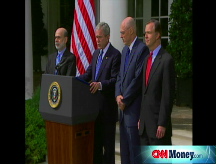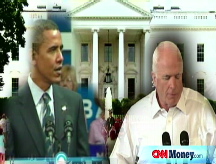$700B bailout: The latest
Washington is racing to pass a historic intervention - and there are still more questions than answers.
NEW YORK (CNNMoney.com) -- The Bush administration has filled in one big unknown about its proposed bailout of the banking system - the price tag.
But many more questions have emerged as Democrats push back.
The $700 billion plan, the most sweeping intervention in the financial markets since the Great Depression, is aimed at stemming the credit crisis roiling Wall Street and threatening the global markets.
Here's what we know so far:
The plan: According to the administration's proposal, the federal government would buy up as much as $700 billion of illiquid assets at a deep discount from banks. The program has been expanded beyond just problem mortgages and will now include other problem assets.
The Treasury Department would run the program directly, unlike the savings and loan crisis of the 1990s when Congress created the Resolution Trust Company to spearhead a financial bailout.
"The federal government must implement a program to remove these illiquid assets that are weighing down our financial institutions and threatening our economy," said Paulson.
What remains to be seen is how the Treasury Department will structure the purchases and what price they'll pay.
The timing and scale of purchases would be at the government's discretion. The price would be established through "market mechanisms." One method that Treasury has suggested is a reverse auction to set the discount at which the assets would be picked up.
The window for the government to purchase the bad assets closes after two years. Private money managers would oversee the assets while they are in the government's possession.
Paulson, speaking Sunday on television, clarified that firms with business operations in the United States are eligible. The original legislative proposal said that only banks with headquarters in the United States qualify.
The cost: While the proposal calls for the purchase of as much as $700 billion of bad loans, it's unknown what taxpayers would ultimately pay for the bailout.
The government will likely buy the assets at below-market rates and hold onto them until the market recovers. Ideally, the loans could then be sold at a gain.
"We're talking about hundreds of billions of dollars, but remember this is not an expenditure, this is money that is being used to purchase illiquid mortgage assets that are very difficult to value," Paulson said on NBC's "Meet the Press." "They will be held [by the Treasury] and they will be resold at some time. And so we can't determine what the cost is today. That's going to be based on how quickly the economy recovers, what happens in the mortgage market."
It's possible that Americans won't end up on the hook.
"The government could make a profit, a substantial profit," said Jaret Seiberg, a financial services analyst at the Stanford Group, a policy research firm. "The pricing mechanism is going to be central."
As part of the program, the administration wants Congress to increase the nation's debt ceiling. Currently, it's set to rise to $10.6 trillion for fiscal year 2009, which starts Oct. 1. The proposal calls for the limit be increased to $11.315 trillion to accommodate the purchase of the mortgage-backed securities.
Will it work? The jury is still out, although experts are cautiously optimistic the plan will help the housing market - and therefore the economy - recover.
The plan will help banks shore up their balance sheets by removing hard-to-value assets. This would address the seemingly endless rounds of writedowns and capital raising that have been rocking the financial sector.
Without these bad loans weighing on their books, banks may be more willing to lend. Or at least that's the goal.
Naysayers, however, worry that many banks may be turned off by the haircut they'll have to take. If these assets are purchased at a deep discount, the banks could have to take a huge writedowns, which may hurt their operations and ability to raise capital.
Also, some experts warn that the bailout will not automatically make banks profitable, nor will it stop the slide in home values that is wreaking havoc on the economy.
But Paulson argues that this plan will help the economy directly.
"The biggest help we can give the American people is to stabilize our financial system right now and to prevent the system from clogging up, because if it does clog up, this is going to have an adverse effect on people's abilities to get jobs, on their budgets, on their retirement savings, on lending for small businesses," Paulson said on ABC's "This Week" Sunday. And so, that's where the first priority has got to be.
Will it help homeowners? It's unclear at this point. If the government buys an entire securitized loan, it could opt to help struggling homeowners by modifying the terms. This could include reducing a loan's interest rate or principal balance.
But it could prove difficult to snap up all the securities sold on a mortgage, experts said. And as long as investors still hold a piece, they could block any changes to the loan.
If the plan doesn't stem the tide of foreclosures, home prices will not stabilize and the economy will not recover, experts said.
Next steps: Lawmakers are reviewing the plan and have scheduled hearings on the matter in the next few days.
While the administration and congressional Republicans are pushing for a "clean and quick" deal, Democrats are voicing concerns about struggling homeowners.
"You have got to deal with that issue of foreclosure, or this problem will persist," said Sen. Christopher Dodd, D-Conn., head of the Banking Committee.
House Speaker Nancy Pelosi, D-Calif., said Democrats believe a responsible solution should include independent oversight, protections for homeowners and caps on executive compensation.
"We will not simply hand over a $700 billion blank check to Wall Street and hope for a better outcome," she said.
A deal could be hammered out as soon as this week. ![]()








